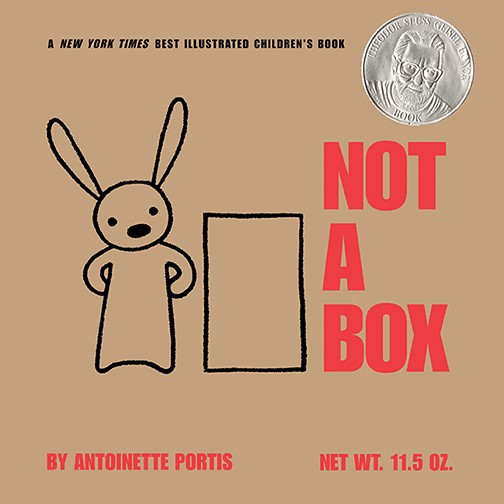This month's Book Nook topic is...
Turn Book Reading into a Conversation with
Not a Box

Children benefit when adults read with them, rather than to them. What’s the distinction? Reading with a child means that they are actively engaged in a conversation throughout – giving them more opportunities to practice their language and literacy skills. When you turn book-reading into a conversation, children are more likely to:
- Understand the story
- Talk about their interests
- Connect what happens in the book to their own life
The Book:
Not A Boxby Antoinette Portis
Why We Chose This Book
There’s something wonderful about the possibilities of an empty box. In this book, we meet a rabbit who turns an empty box into a number of fun and imaginative props such as a race car, a robot and a hot air balloon. This simple and relatable story draws on children’s imagination and experience with pretend play and offers many opportunities to pause and invite the child to share their knowledge and ideas.
Get the Conversation Started
The first step in turning book-reading into a conversation is to Observe, Wait and Listen (OWL™). This means finding times to wait, without talking, while you observe the child to see what interests them about the story. They may smile, point or say something about the story. This is an important strategy because it helps you find out what the child is interested in, making it easier to encourage conversation. Some good times to wait during book reading are:
- Before or after you turn the page
- After you make a comment about the story
- After you point to and comment on an illustration
- When something exciting happens in the book
- After you ask a question
Once the child has shown you what interests them, Follow the Child’s Lead by making a comment about what they noticed or communicated. For example, read the title and then wait before you open the book. If the child repeats the word “box”, you could say, “Yes, that is a box! I wonder why this book title says it’s not a box.” After you comment, wait again to see what the child says or does next.
Keep the Conversation Going
Try to keep the conversation going back and forth by using a balance of comments and questions related to the child’s interests. Ideally, you’ll be able to keep the conversation going until you’ve each taken two or three turns. There are many different directions the conversation could take, but here are a few examples of what you could talk about while reading Not a Box.

Make Predictions
Making predictions about what might happen is a great way to build back and forth conversations and encourage children to draw on their knowledge, experience and reasoning skills to deepen their understanding of a story.
After the child has seen the first couple of pages in this book, pause before turning a page and ask a question like, “What do you think the rabbit will turn the box into next?” Wait to give the child a chance to continue the conversation. After the child responds, you can make a prediction of your own, like, “I think the rabbit will turn the box into a bathtub! Let’s see what he does next.”
Talk About the Child’s Experiences
Relating what’s happening in the book to a child’s existing knowledge and experiences is a great way to build the their understanding of the story and keep the conversation going.
With this book, you could ask the child, “Have you ever played with an empty box before? What did you do with it?” Listen to the child’s experiences and share some of your own! Keep the conversation going for several turns by commenting and asking questions that invite the child to contribute. Remember to wait after making a comment or asking a question. Waiting gives the child time to think and respond with a comment of their own.
Continue the Conversation Beyond the Book
After reading Not a Box, children may want to play with some empty boxes to re-enact what happened in the story or to imagine new ways to play with a box. Keep the conversation going by continuing to talk about their interests.
For example, if the child turns their box into a robot, ask, “What does your robot like to do?” Wait for the child to respond and then make a related comment. If the child says their robot likes to play games, you could say, “Having a robot that likes to play games would be really fun because you’d always have someone to play with!”
Children are likely to enjoy hearing and talking about this story again and again. Revisiting the same book encourages children to contribute to the conversation in new ways with every reading!
Happy rhyming and reading!
More Resources
The strategies in this Book Nook post are drawn from Hanen’s practical, research-based guidebooks for building emergent literacy. Explore the links below to learn more about how these guidebooks can support you.
For Parents I'm Ready! guidebook
I'm Ready! guidebook
For Educators ABC and Beyond guidebook
ABC and Beyond guidebook
